Whilst the World Cup has understandably been the primary focus for many fans during the last couple of months, attention in the women’s game is quickly turning back to the domestic calendar, with several of Europe’s major leagues getting back underway during the coming weeks and the prospect of the title battles to come causing many to lick their lips in anticipation.
For some teams, the aim will simply be to improve on last season’s fortunes, while others will hold hopes of topping their divisions and prising silverware out of their rivals’ grasps. For a few, though, this season is about taking first steps into previously unchartered waters, and one of those falling into that category is Manchester United Women, who will be embarking on a new adventure as they experience UEFA Champions League football for the first time in their history.
Competing on four fronts is a challenging task, with those who manage it having solid squad depth and good player rotation policies, keeping the whole team fresh and ready for each outing. For those who haven’t been through that process before, it can be a little daunting, especially as rest periods are significantly less than players might be used to, so new recovery timelines must be implemented and strictly followed.
With that in mind, this tactical analysis will examine whether Manchester United is ready for the challenge ahead, both from a tactical perspective and when looking at the players currently available. It will also highlight a few areas where some question marks still need addressing.
The forward line
Under Marc Skinner, Manchester United Women have put a great emphasis on being positive in attack and on posing as significant a threat as possible in possession, and there are several critical tactical aspects to their final third play that last season enabled them to stay on Chelsea Women’s toes and to test their title credentials.
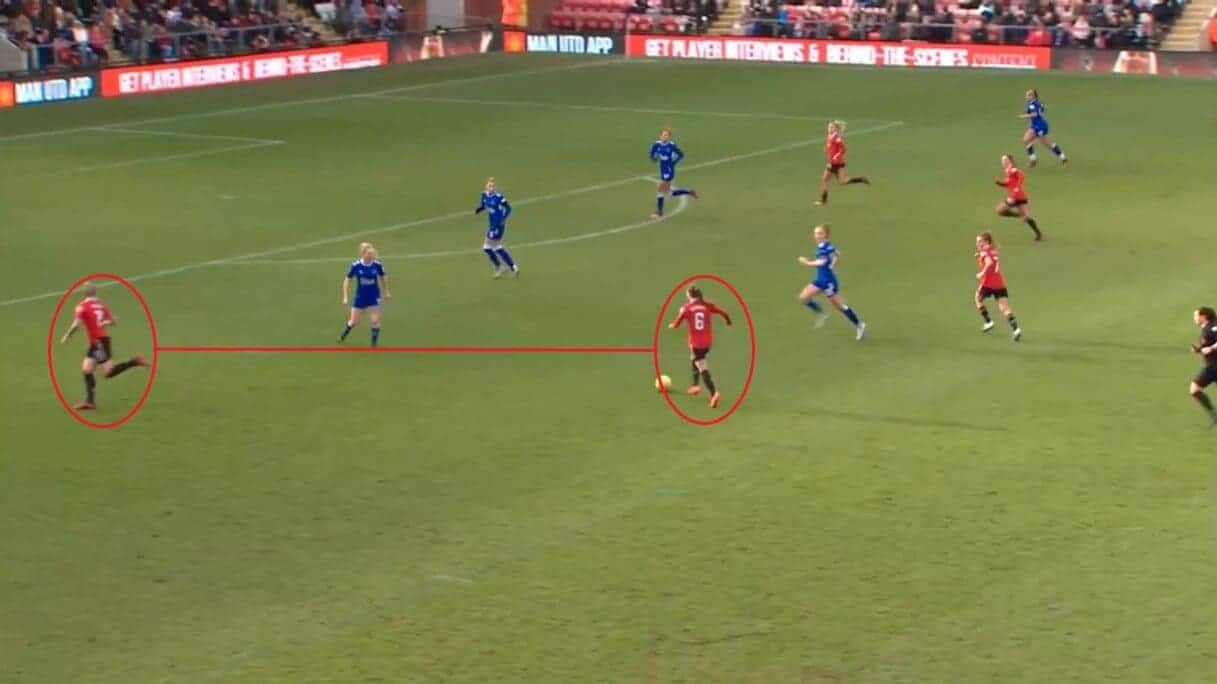
The most notable of those was their desire to make full use of the wings when creating chances, with their first thought once they had secured possession often being to progress the ball into the wide channels and to allow those on either side of the pitch to make dangerous runs behind the opposing defensive line and to create goalscoring opportunities.
Leah Galton proved to be particularly adept at this, ending up as the club’s joint-top scorer in the WSL last season alongside new Arsenal Women striker Alessia Russo, with both finding the net on 10 occasions.
It is not surprising that Skinner has asked his players to spread the play out to the wings so much, as it was an essential aspect of Orlando Pride’s tactics back when he was in charge of the NWSL club.
He has needed to adjust Manchester United’s mentality to play this way, with them previously using players who could cut inside the pitch to work closely with the central striker when Casey Stoney was in charge. He has needed to add players who can implement his game plan in those areas (Nikita Parris, Lucía García and Adriana Leon have all joined since his appointment), but last season showed that his key messages are being taken in by the squad and also that they are leading to success on the field.
It is not only the wingers who have been asked to have a more front-footed mentality, though, as the full-backs have also been given greater freedom to push up the field and support the team’s final third play.
In this case, Hannah Blundell, another of Skinner’s acquisitions, has possession in an advanced area and is linking up with Galton to draw the Everton Women defence inside the pitch and give the winger time to run behind them when there is enough space for her to do so.
It was the same story on the other side of the field when looking at how new Barcelona Femení player Ona Batlle worked closely with whoever was deployed on the right side of Manchester United’s attack.
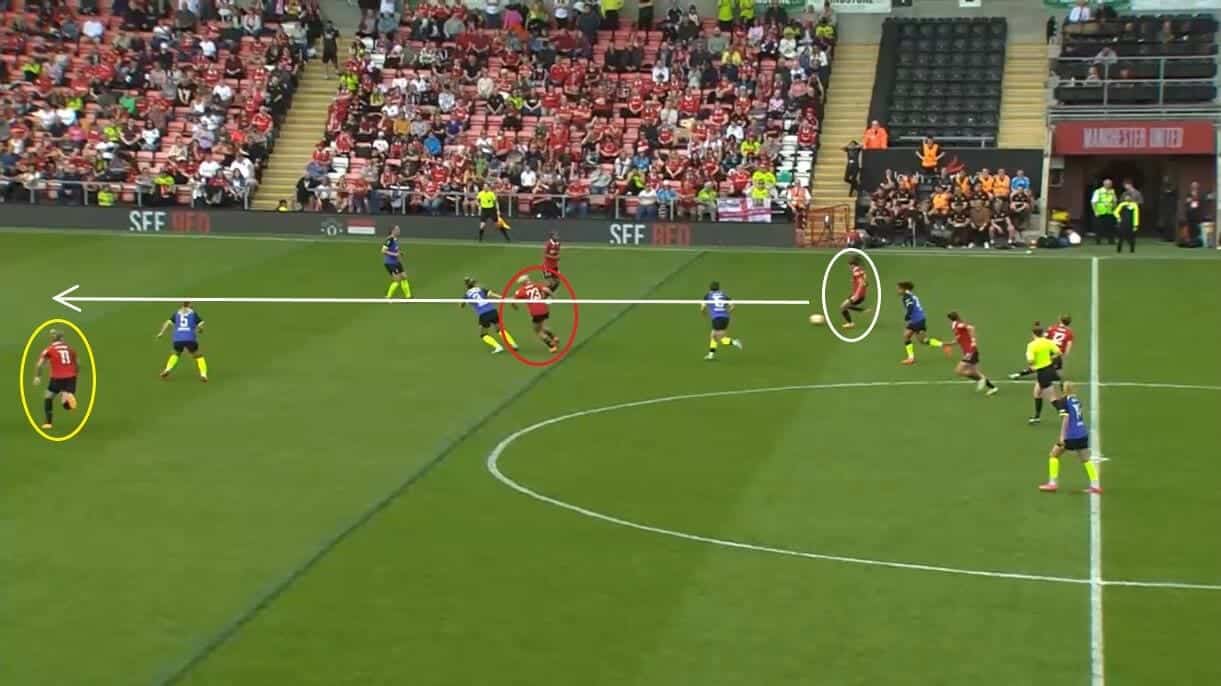
To facilitate this, the striker (normally Russo) was often seen last season dropping back and getting into pockets of space between opposing lines. The fact that she averaged just 4.87 touches in the penalty area last season shows how often she was involved in the build-up play and not necessarily in as much finishing as some might have expected.
However, as England’s performances in the latter stages of the World Cup showed, this style of play does suit Russo’s individual strengths, with her preferring to drop deep and then turn and run behind when she gets the ball.
It also makes life a lot more difficult for opposing defenders, as they are put in a tricky position whereby they need to decide whether to go with Russo or to hold their positions and stop the wingers from breaking through behind them. In this case, Tottenham Hotspur Women have been put in that position and need to recover quickly to prevent Galton from having a clear route to their goal once played through by Norway midfielder Vilde Bøe Risa.
Molly Bartrip tracked the winger well on this occasion, preventing her from shooting at goal. Still, many have fallen into this trap and have been unable to limit Manchester United’s tendency to finish chances off when in these same positions.
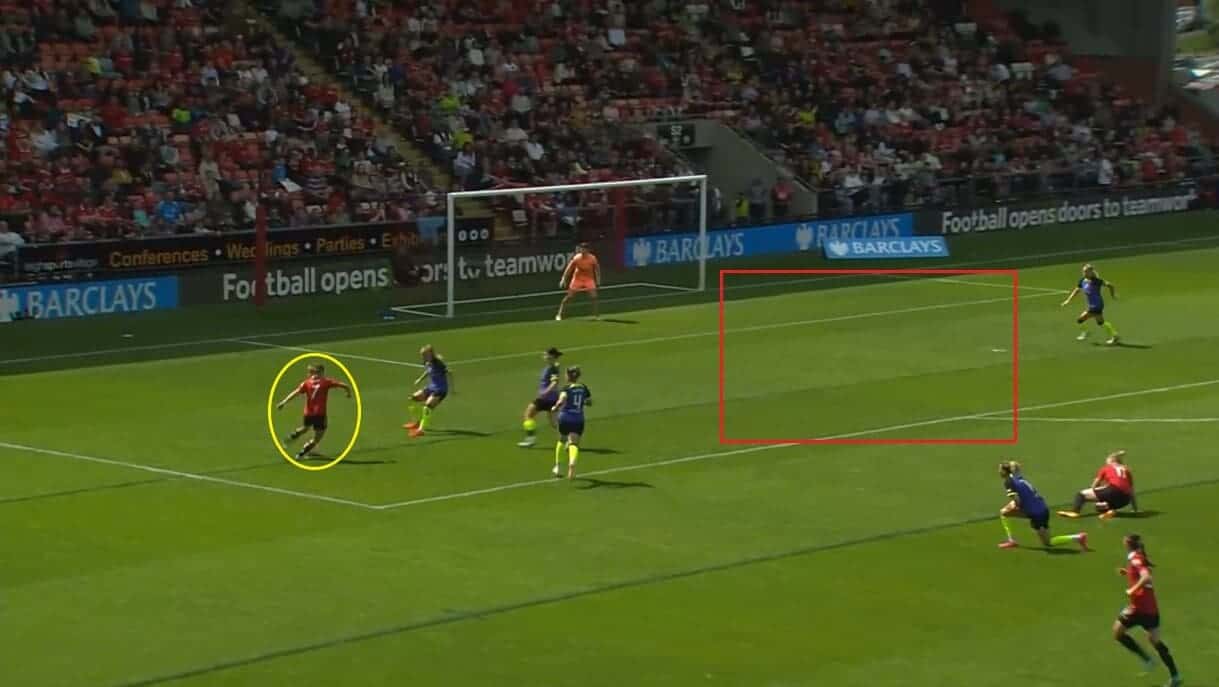
It is a risky way of playing, though, as it relies on the wingers making the runs as soon as the striker drops back, and that has only sometimes been the case when Manchester United have had the ball. In this situation, Galton has not run forward, as she was instead involved in the build-up. She combined with Ella Toone to move the ball forward after the England midfielder had successfully won it from Tottenham’s Wales international Angharad James.
As can be seen, though, there is no player in the middle, and Toone now can’t set up a chance for a teammate, with the result being that Tottenham captain and Canada centre-back Shelina Zadorsky can intercept her pass to end the threat. With Manchester United averaging 62.71% possession last season but scoring 10 fewer goals than Chelsea, there is clearly something there for the team to work on, and it is something that they will need to address if they are to compete on all four fronts next season.
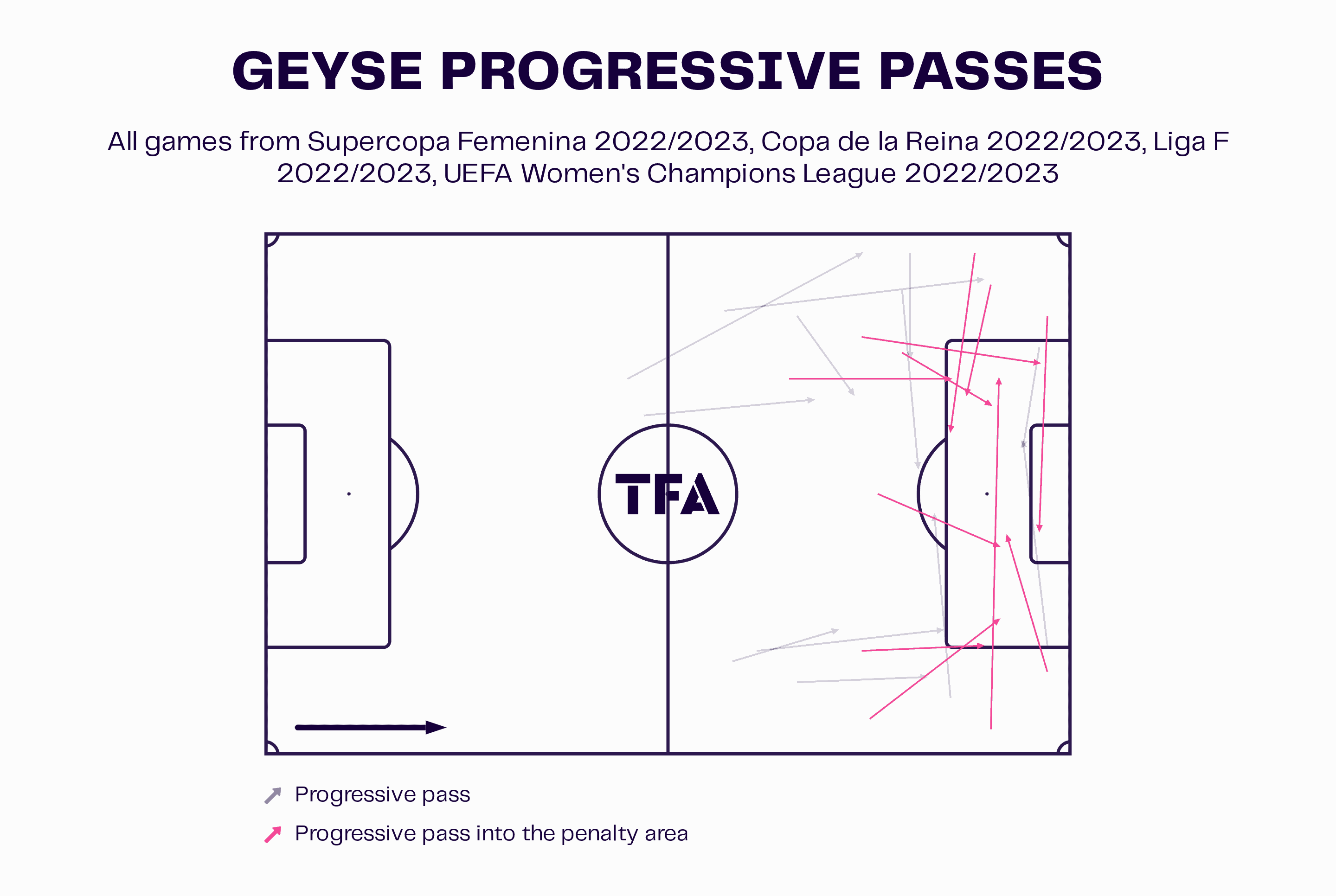
With that in mind, finding the right player to replace Russo will be critical. Manchester United do look to have found someone who can offer the same qualities in Brazil international Geyse Ferreira, who has joined from Barcelona. She only moved to the Liga F giants from Madrid CFF last summer but has struggled to establish herself as a regular starter.
However, her key strengths would match Manchester United’s profile: she can drop back, link up play, and lead the line. Her goal threat when she does get the right chances to score cannot be underestimated (she found the net 20 times for Madrid in her final campaign with the club, topping the scoring charts alongside Nigeria striker and future Barcelona teammate Asisat Oshoala).
Another reason that Skinner has moved for the Brazil forward is her versatility, with Barcelona using her in all three front-line positions last season, and it was often the case that she was used to replace anyone that head coach Jonatan Giráldez felt was underperforming or needed a rest.
Constantly changing positions and roles would phase many players and leave them unsettled — but not Geyse, who adapted to each alteration with aplomb, and this graphic indicates through the directions of her progressive passes how she asked questions of defences from all three channels.
There is no doubt that she can be relied upon at Leigh Sports Village next season to make intelligent decisions and to both lead the line and drop back as necessary, and she is not a bad player to bring in to replace what they have lost through Russo’s departure.
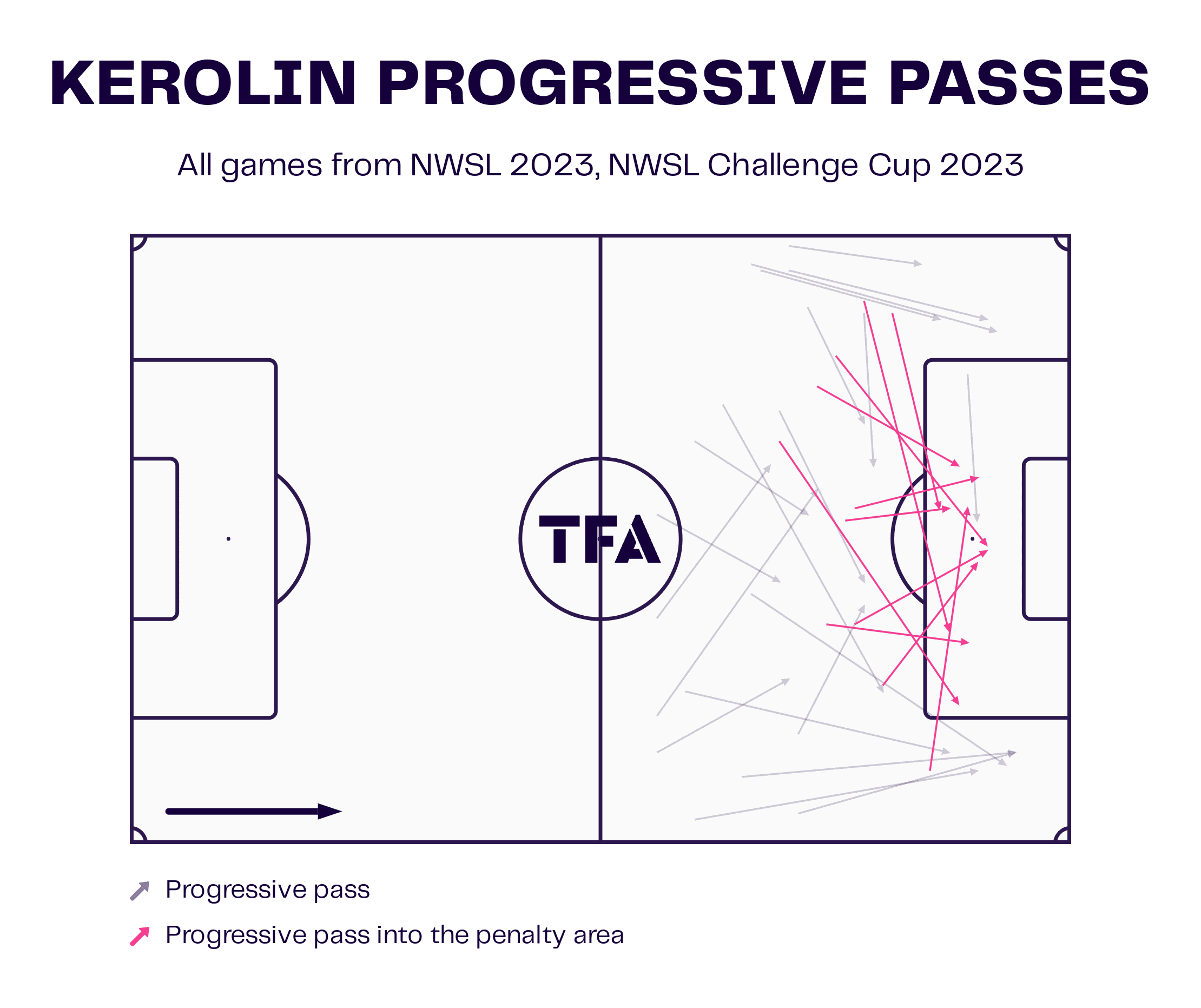
Another player heavily linked with a switch to Manchester United this summer is Geyse’s international teammate Kerolin. Currently featuring for NWSL high-flyers North Carolina Courage, she has established herself as their main attacking threat this season, following the departure of Mexico striker Diana Ordóñez to Houston Dash in the close season, with her finding the net on seven occasions so far.
Courage head coach Sean Nahas has used Kerolin in a very particular way in 2023, with her movement off the ball helping to manipulate opposing defences into leaving gaps open and allowing those behind to then move forward and use the spaces available to create chances. This tactic has worked for them and helped them to the division’s summit before the World Cup break.
For Kerolin, teams using her movement and ability to provide links and create spaces is nothing new, with Brazil head coach Pia Sundhage utilising those aspects of her game during their World Cup run as she tried to help the team move the ball through the thirds.
For those who have been watching her, which seems to include Manchester United, that has allowed them to witness a different side to her game and one that coaches who like their forwards to be mobile and to want to get on the ball will appreciate. Again, it allows her to fit the same profile as Russo, meaning that adding her to the squad would not lead to Manchester United needing to change much stylistically.
The issue, though, is that Manchester United would simply be adding the same types of players as they have just lost, and that means that they would lack dimensions when creating chances. Against most teams, that will be fine, but when they come up against a side that does know how to defend effectively against them, they could leave themselves without a backup plan to turn to.
Midfield balance
With so much importance labelled on how Manchester United Women use their wingers when they are on the attack, the midfield is often tasked with simply moving the ball around the field and supporting the forwards wherever they can.
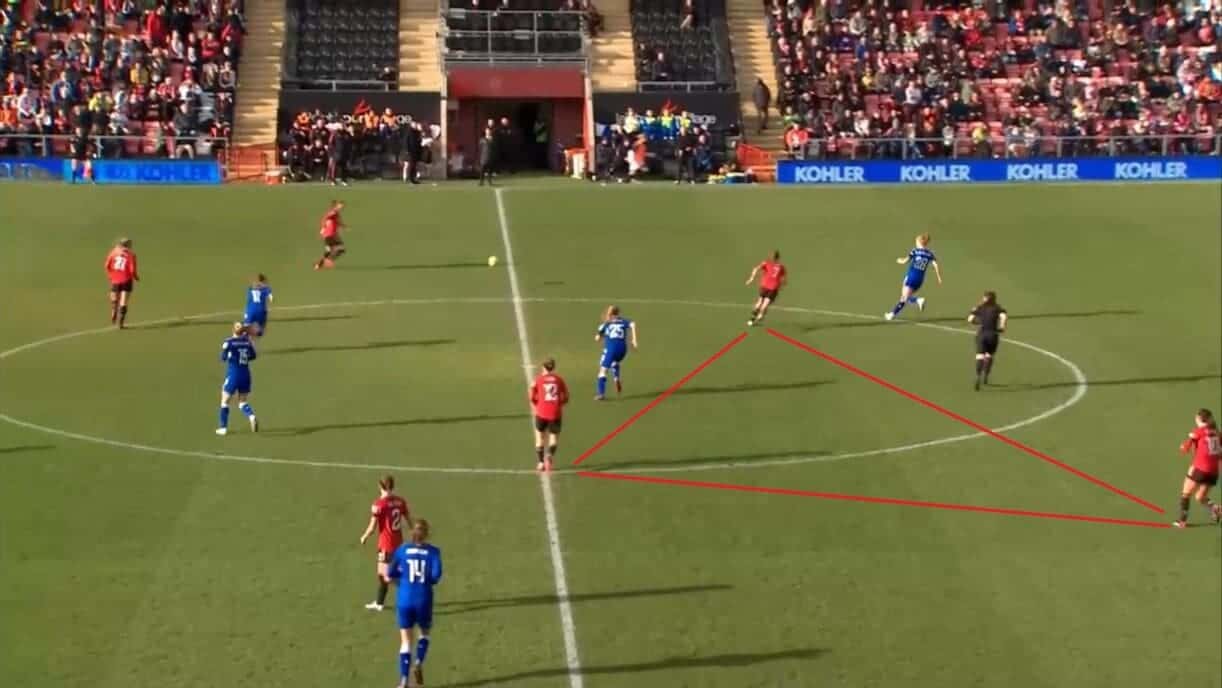
As such, it has been common to see a triangular structure form in the central third during their matches, and more often than not, it is formed with the numbers being further back in the shape of a double-pivot.
However, what is important to point out is that there are different variations and configurations that Manchester United can utilise, with them having different profiles of midfielders, therefore, the ability to bias this shape towards supporting attacks or protecting the defence as needed.
Against Everton, with their 3-4-3 setup, Skinner felt that a balance was required. So he started Wales’ Hayley Ladd in defensive midfield, Toone as the 10 and then deployed captain and fellow England midfielder Katie Zelem in a box-to-box role, and that allowed the team to have numbers higher up the pitch when they had the ball and added protection as soon as it was lost.
Two defensive players might be deployed if they were playing a team who stayed higher up the pitch. In contrast, a team that Manchester United knew they would dominate possession against might see two attack-minded players starting, and that is where the variation comes into their play.
When looking at their task during the coming season, it is clear that Skinner is looking to give himself as many different players as possible, with him already having Zelem, Toone, Ladd, Bøe Risa and fellow Norwegian Lisa Naalsund in the team, whilst the highly-rated talent Emma Watson has joined from Rangers Women and experienced Portugal international Tatiana Pinto is rumoured to also be on the shopping list after her departure from Levante Femenino.
Some have criticised the volume of midfielders currently on the team’s books. Rightly so, as Skinner has been reluctant at times to hand a few players the same amount of time on the field as others, but this season it could be important that there are so many options available to him that will allow them to adjust their midfield structure depending on who they are coming up against.
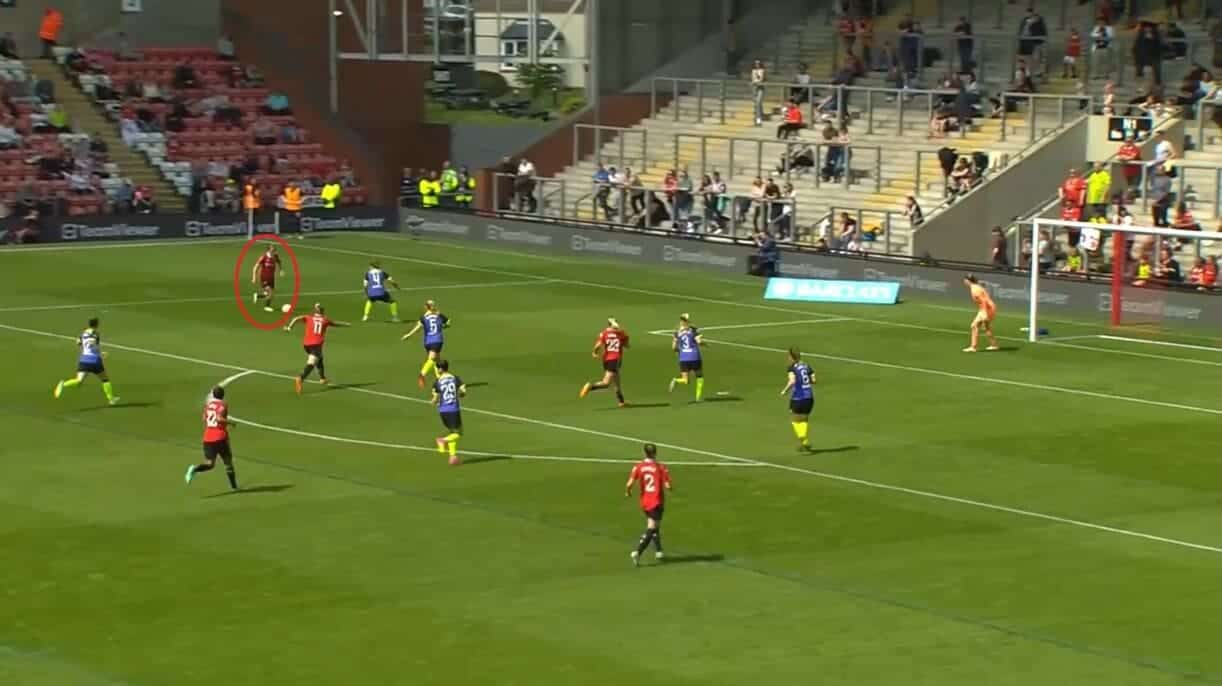
The other issue that Manchester United have had through asking their midfielders to support the forward line is that key players have been used in areas where they are not at their best.
Toone is an excellent example of that, with her at times deployed as a winger in the team’s 4-2-3-1 system due to Galton playing so centrally, but that limits her ability to impact the game and is one of the reasons that the 2022/23 campaign for her was largely underwhelming, with her assisting seven goals but only scoring three times (and not finding the net since November).
This is a perfect example of the issues it causes because she has received the ball on the far side of the pitch and is looking to create either a shot or a chance for someone else but cannot do so due to several Tottenham players standing in her way. As a result, her pass is easily cut out by a combination of former Manchester United defender Amy Turner and New Zealand midfielder Ria Percival, bringing the attack to a swift and premature end.
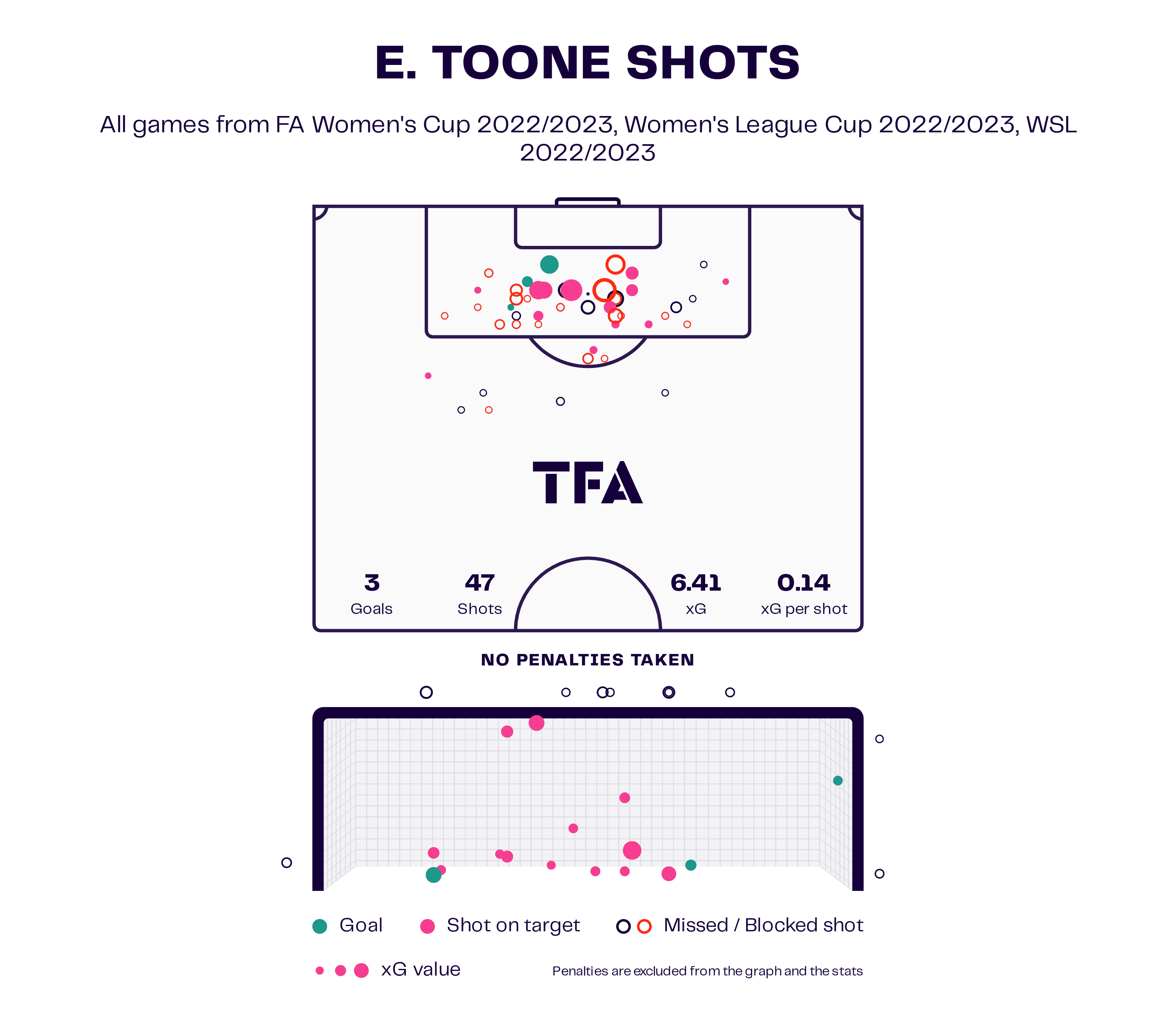
For all of Toone’s attacking qualities, crossing and creating from the wide channels is not something she thrives in, with her only averaging a 51.3% crossing accuracy last season. Indeed, when looking at this graphic, it is clear to see how significant a threat she poses when allowed to play more centrally, with most of her efforts and goals coming when she is in the middle of the pitch.
It was a role that she frequented so often during Stoney’s time in charge, and Skinner has tried to keep her playing in the same areas of the pitch where he can. However, because of his desire to put so much emphasis on the wingers creating and scoring chances, Toone has needed to move around more than she perhaps likes to have as significant an influence on the game, and that has often been what has let her down as she has looked lost when without the ball.
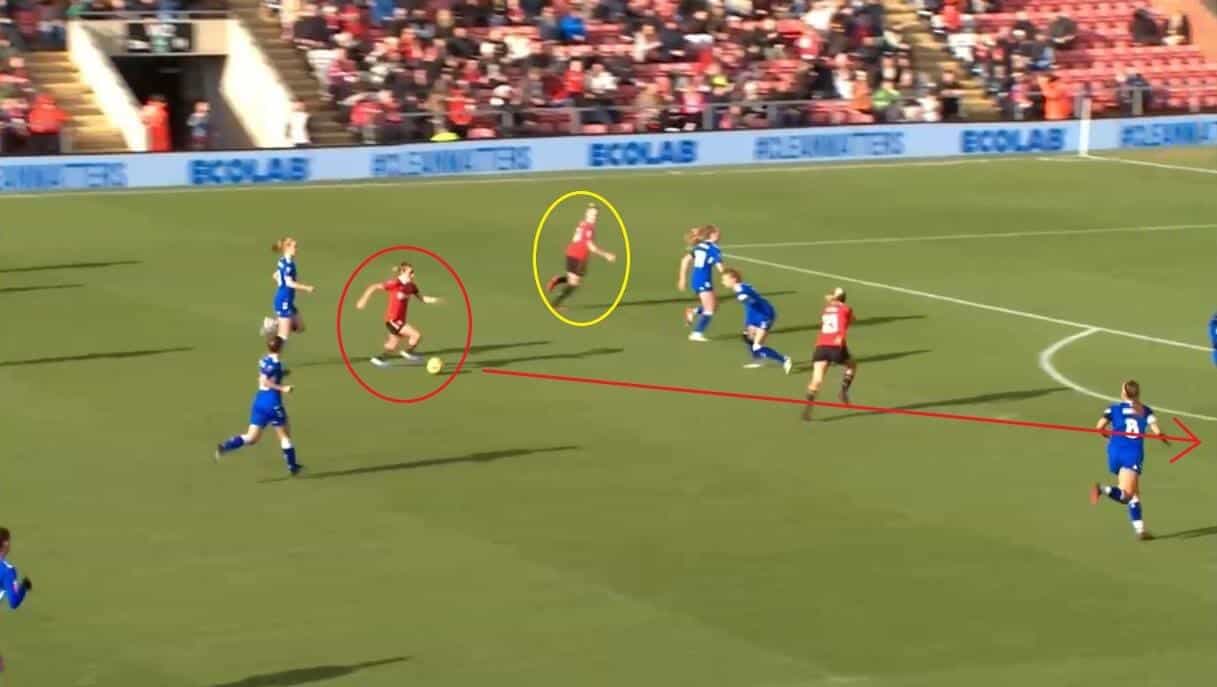
The confidence she plays with when she does get on the ball in her favoured areas is evident for all to see — and the match against Everton was one where she appeared at ease with what she needed to do.
Here, for example, she has Galton on her outside and so doesn’t need to move towards the wing, meaning that she can focus entirely on where the space is on the near side of the field and on giving García (out of picture) something to run onto behind the Everton back line. The fact that her pass had pinpoint accuracy and allowed the former Athletic Club Femenino player to test the Everton goal here showed again how dangerous Toone can be when in these areas of the field, and it only didn’t lead to a goal through García’s effort coming back off the woodwork.
However, Everton were caught on the back foot here by the speed of Toone’s incisive attacking play, and this is why Manchester United need to keep her in these central spaces as much as possible.
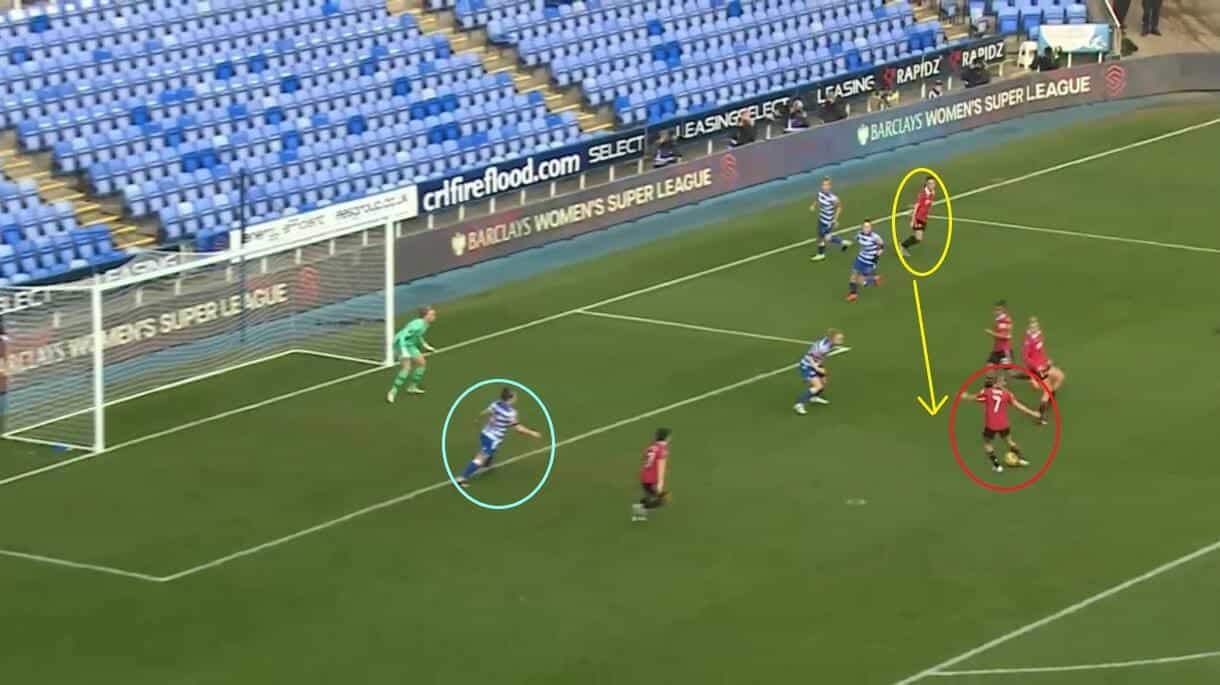
It’s not only about the shot creation, though, as Toone can also pose a much bigger goal threat of her own when in the middle of the pitch, with the graphic shown earlier in the scout report indicating that she was at her most lethal when not out on the wings.
In this case, Manchester United have moved up the field and have again found space to progress the ball, with Reading Women unable to keep them back. However, this time, Toone has not been as involved in the build-up play and has instead focused on getting herself in the right place to control Batlle’s cutback and to shoot at goal with as much power and precision as possible.
Now-former Reading defender Emma Mukandi denied her effort on this occasion. Still, the fact that she was able to get the shot away in the first place is the critical point here, as it once again highlights how Manchester United always have a better dynamic and appear more connected when Toone is in her best position.
If they harbour any hopes of challenging in all four competitions in 2023/24, they will need to ensure this is the case as often as possible.
Defensive setup
When it comes to the defensive side of things, what is evident when watching Manchester United Women play is that, regardless of whether they are winning or losing, they again have a clear identity and a good understanding of what each player needs to do in each situation, and that is one of the reasons that they had the best record in the WSL last season with just 12 goals conceded in their 22 matches.
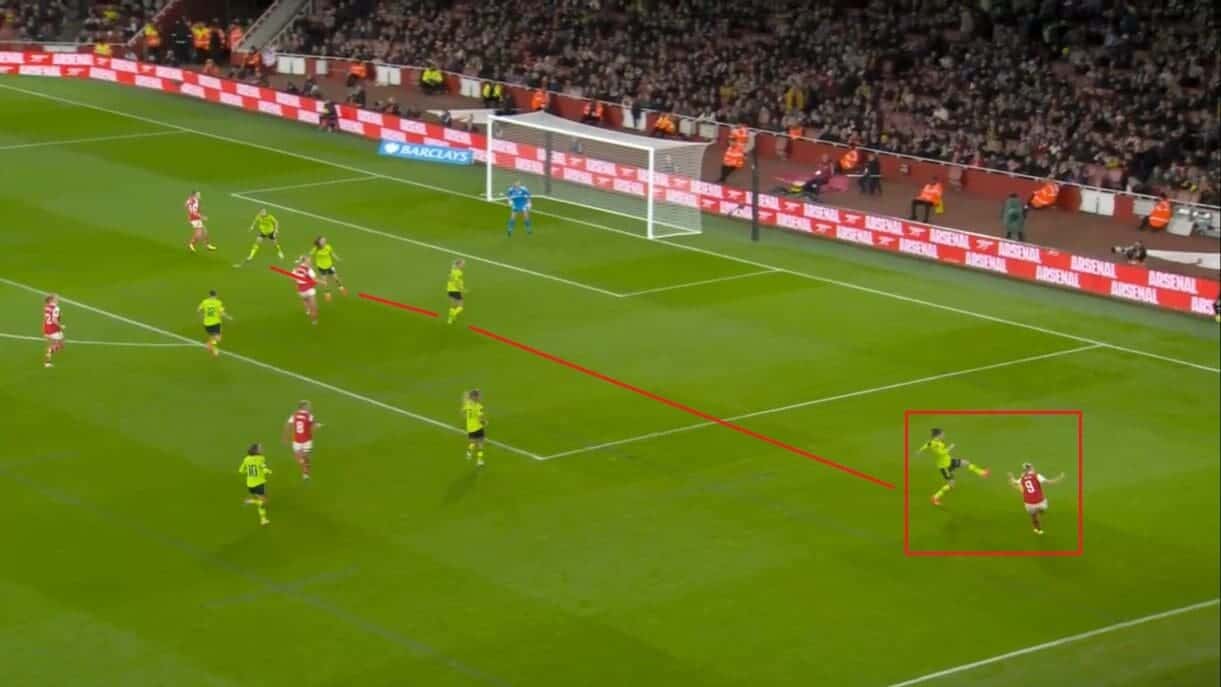
As mentioned earlier in the analysis, defenders are often caught when deciding whether they want to press the opposing ball carrier or stay back and limit the runs behind them. For Manchester United, though, there tends to be a blend of both, with them bringing three of their back four together and allowing the player nearest the ball to move out and close it down, and that is precisely what is happening here against Arsenal, with Blundell the one to move out and get tight to Beth Mead.
The reason that Manchester United set up in this way is that it gives them something to fall back on should the initial press not work out, as they would still have enough players available in the middle to clear deliveries from their airspace and to stop opponents from connecting with the ball first.
The fact that they won 47.9% of their aerial duels suggests that they would prefer not to be tested in this way, as it is not the most substantial aspect of their play (and they generally weren’t, as they succeeded in 66.1% of their defensive duels). Still, it does show that they can defend centrally at times and are not an easy team to create chances against.
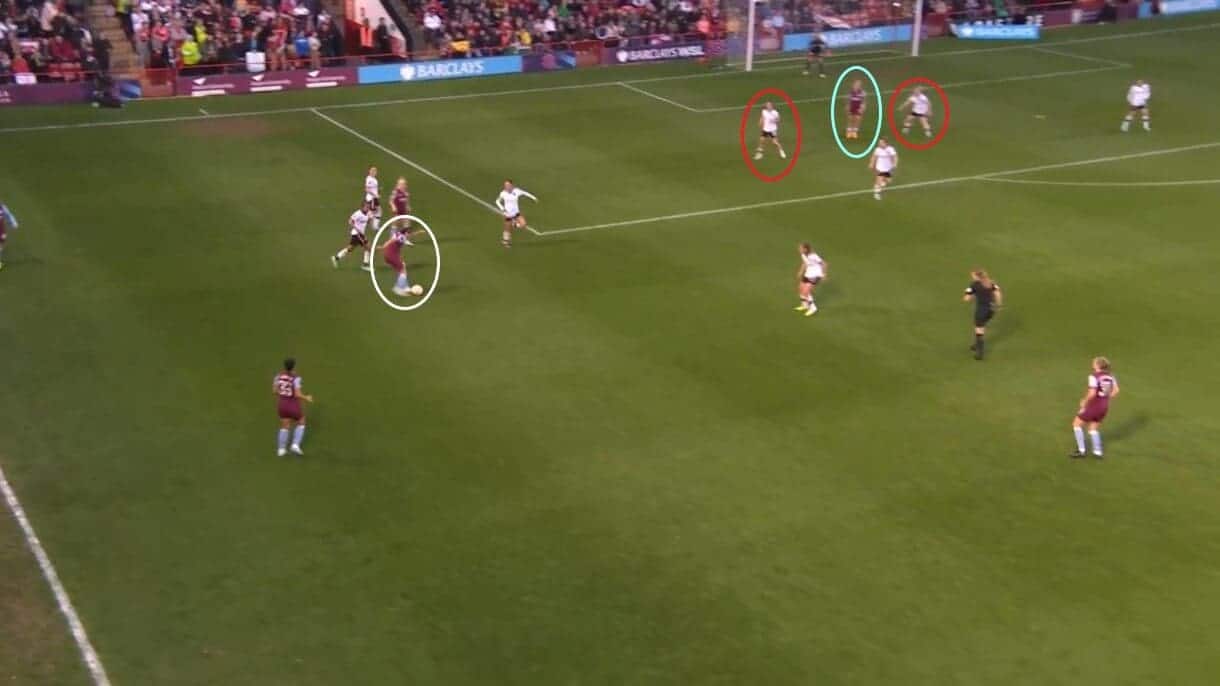
As with anything, though, Manchester United are adaptable and can alter their mentality to focus on different areas when they feel a need to prioritise. When they played Aston Villa Women, for example, Rachel Daly put them under constant pressure inside their third with her constant changes of direction and quick reactions, and she was causing Manchester United no end of headaches.
As a result, they decided that the best way to deal with the England forward’s threat was to focus on closing her down and to not worry as much about simultaneously pressing the ball, with this situation showing how the back four stayed much closer together and took Daly out of the game.
It was a tactical switch that worked well for them, as when France midfielder Kenza Dali sent the cross in here, Daly didn’t have the same freedom to connect with it, so the ball went across goal and out of play.
When looking at how Manchester United have tried to prepare for the prospect of competing on four fronts, it is clear that increasing their defensive options has been one of Skinner’s priorities.
Ensuring that there is a good blend between youth and experience is something that he has been really hot on, with the signings of 18-year-old prodigy Evie Rabjohn from Aston Villa and 27-year-old Wales centre-back Gemma Evans from relegated Reading ensuring that he can plug any gaps that might occur with quick fixes as well as adding new talent that he can develop as he continues to look towards the future.
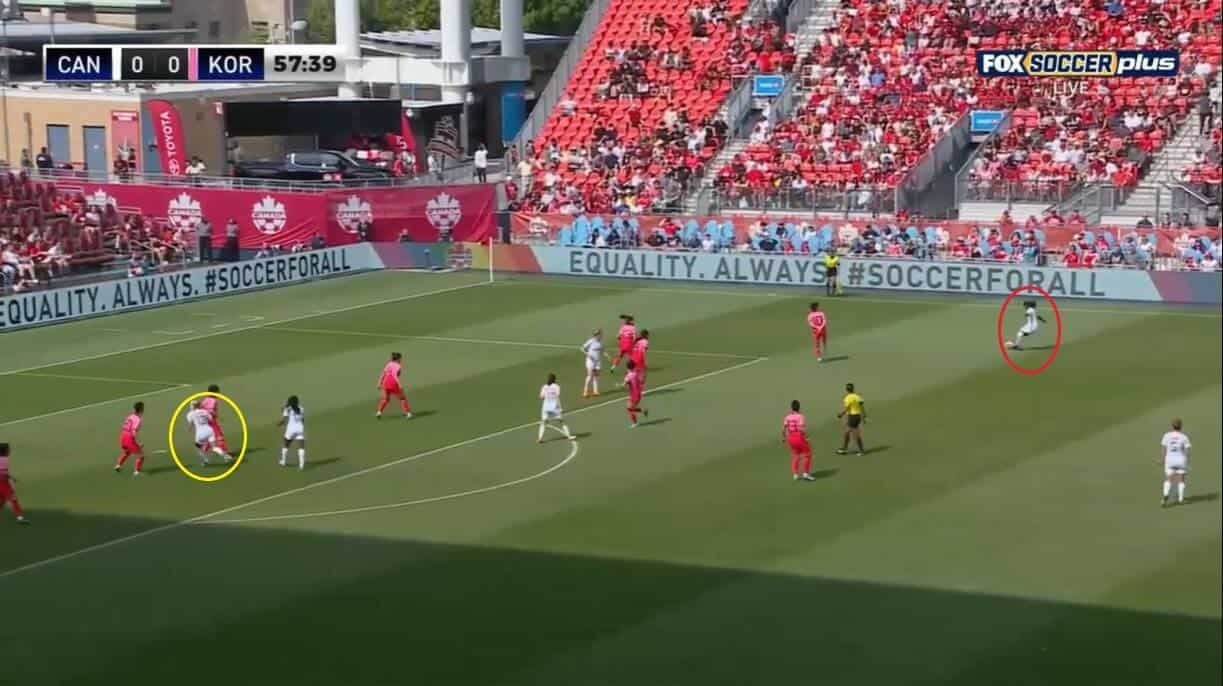
However, despite the strengthening that has been done in central defence, full-back, and particularly right-back, is an area that some fans will still have some concerns over, with Batlle now departed and no news of another player coming in to offer cover and competition for the Spain international’s heir apparent, Canada’s Jayde Riviere.
When looking at Riviere’s game, there is no doubt that she has what it takes to fill the hole left by Batlle this summer; on top of that, fans have been crying out for Skinner to use her more than he has.
In attacking situations, for example, she has shown on plenty of occasions how she can move up the field and send balls into the middle with unerring accuracy, finding teammates in the middle and setting up chances before opponents have had an opportunity to really set themselves up.
On this occasion, clubmate Leon was in the middle but didn’t have as much space as she might otherwise have had, due to South Korea working hard to stay between her and the goal, but there have been plenty of times when Riviere’s attacking qualities have led to shots on goal, and it has proven to many that she is ready to step in and take over where Batlle left off.
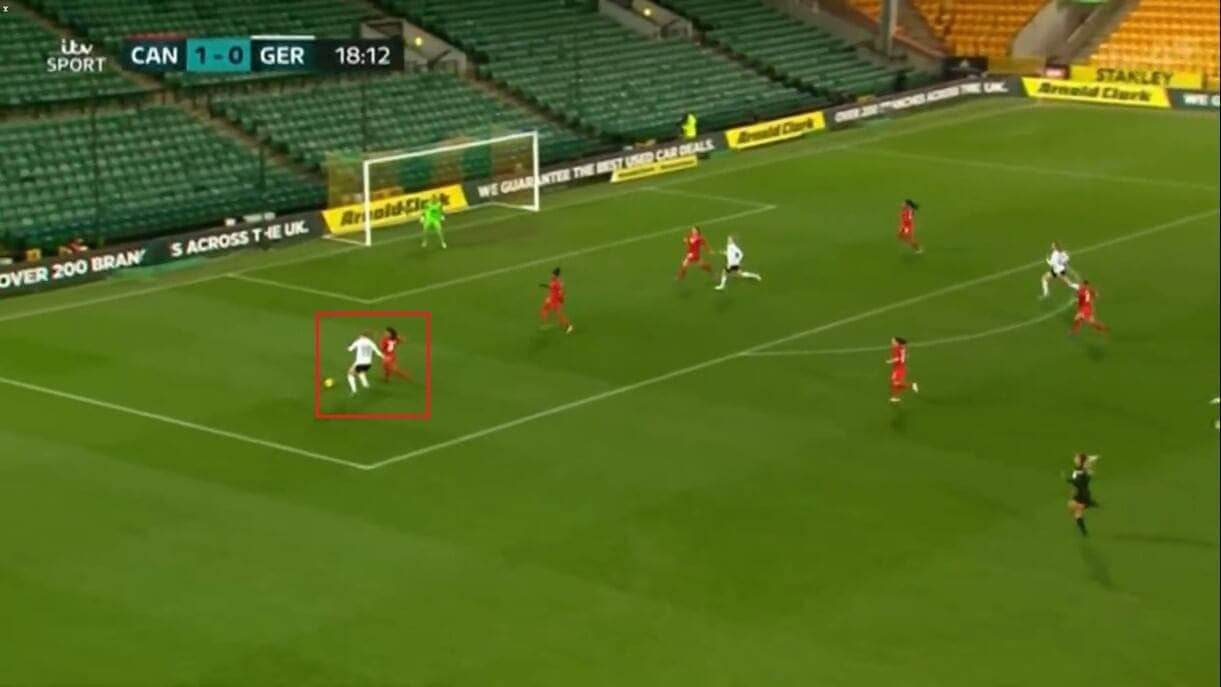
In defence, the Canada international has the bite and aggression when tackling that Manchester United demand from their full-backs, with her getting tight here to Germany winger Klara Bühl during the 2023 Arnold Clark Cup and preventing the Bayern Munich Frauen attacker from getting any further inside the pitch and instead forcing the ball to go out of play.
Again, this was something that Batlle did a lot of during her time at Leigh Sports Village, and so any replacement for her needs to be good at tackling and not to be afraid to put their bodies on the line when required, and Riviere is a player prepared to do that.
However, the fact that she is the only right-back in the team does still present a problem, and Skinner might need to look for solutions from within to ensure that Riviere is given rest time when needed if he is unable to add a new player in the remainder of the transfer window.
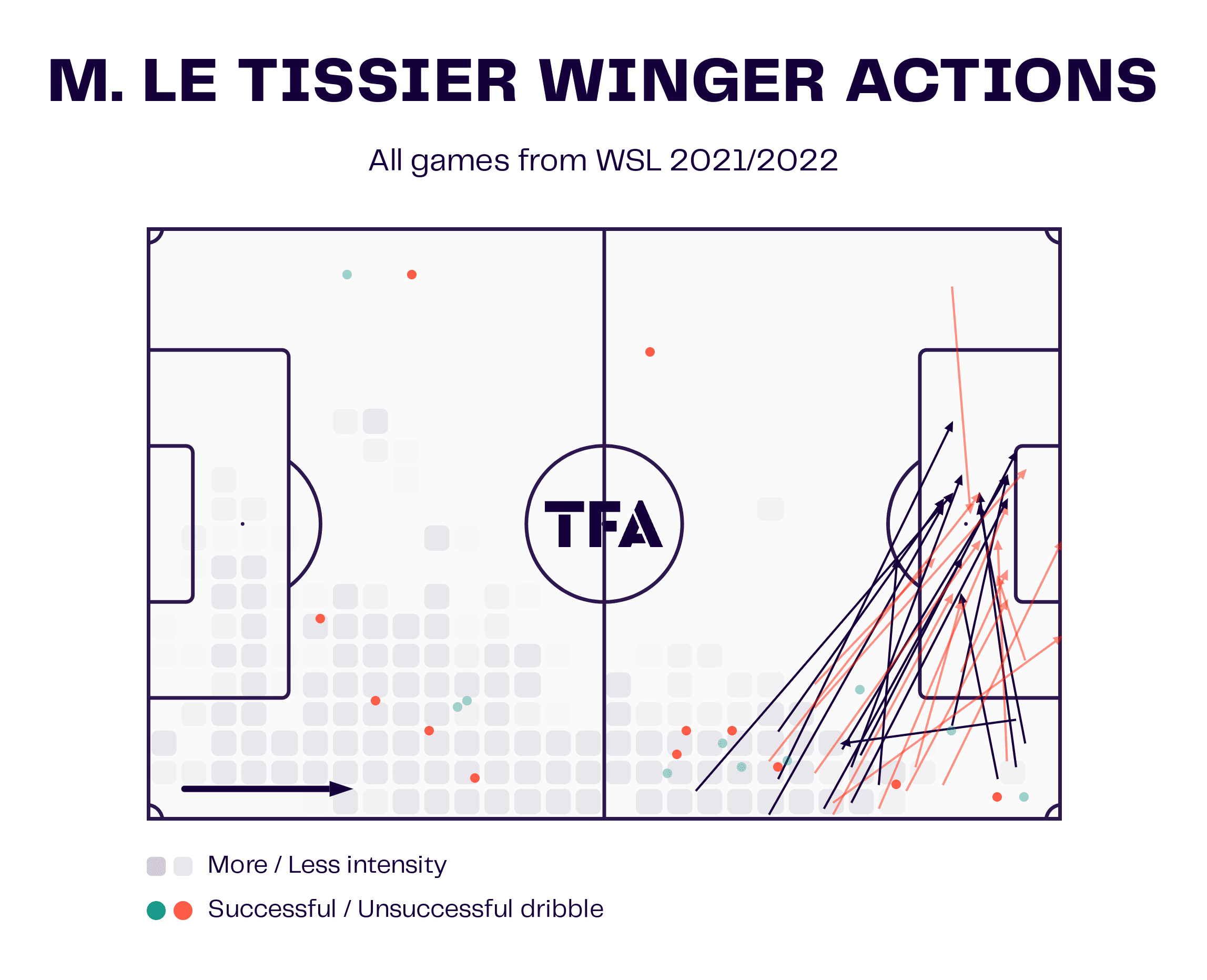
Someone who could fill in for a run of games and who wouldn’t look out of place is Maya Le Tissier, with her featuring as a centre-back since joining Skinner’s team last summer but playing mostly at right-back during her time at her previous club, Brighton and Hove Albion Women.
As this graphic shows, when she was in the wider defensive role, she offered a significant offensive threat, not only through her deliveries but also through her tendency to cut inside and to get into the half-spaces and central areas. That ability to take players on and play really progressively could give Skinner a good alternative if Riviere were ever unavailable.
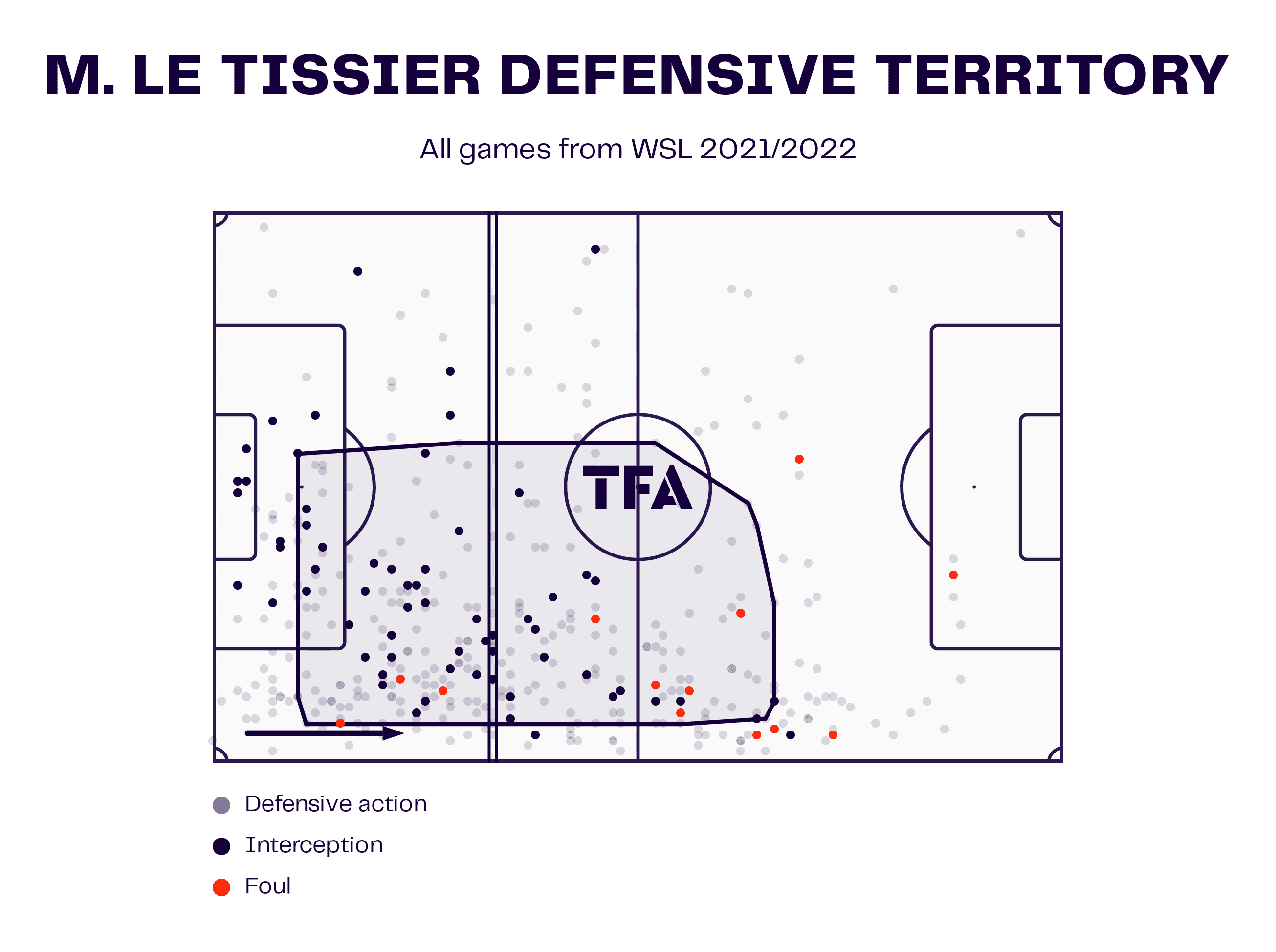
When Brighton were without the ball, Le Tissier was a generally consistent defender who, like Batlle and Riviere, didn’t let many players run through her. As this graphic indicates, she covered a lot of territory for the side when inside her own third and did win a significant number of her 1-v-1 battles, which shows her speed and determination to cover large areas of the pitch and to be tough to beat individually.
The fact that she has been deployed at right-back for England and has played well in that position shows that she hasn’t forgotten the fundamentals of the role since transitioning to central defence in the last year, and with new central defensive options being brought in this summer in the shape of Rabjohn and Evans, it may well be that Le Tissier shifts across to right-back from time to time.
Conclusion
In conclusion, this tactical analysis has taken an in-depth look at Manchester United Women and has analysed whether they are ready to compete on four fronts this season.
From the points raised in the analysis, it does appear that they are on the right track, but a few issues still need sorting out. A replacement for Russo has now been brought in in the forward line.
However, there are still a few question marks hovering over their lack of tactical flexibility if their original plan were not to have the desired effect. In midfield, the main issue is whether they can find a way to use Toone in her preferred role and improve her attacking output. In defence, it is about the cover at right-back and how they can ensure they don’t leave themselves short when they need to give Riviere a break.
If they can address those problems and either add a new player or adjust their tactics where required, then there is no reason to suggest they can’t compete on all four fronts. However, if any of those is not sorted out, it could be tricky to see them replicating their fine form of last season and be in for a tough time.

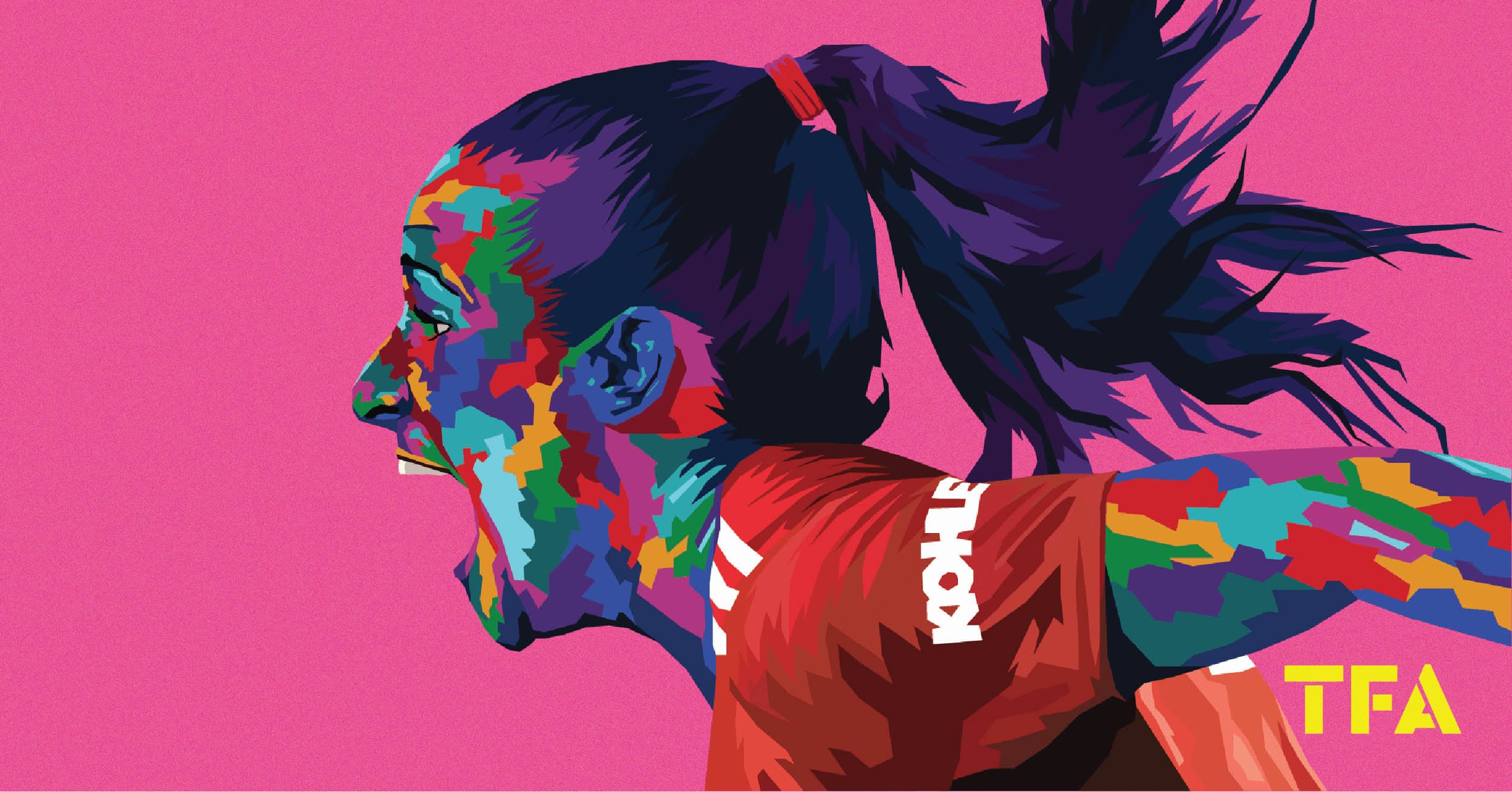


Comments